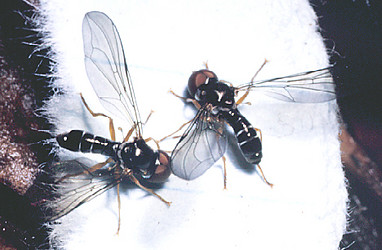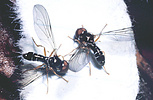Dorylomorpha
Jeff Skevington


This tree diagram shows the relationships between several groups of organisms.
The root of the current tree connects the organisms featured in this tree to their containing group and the rest of the Tree of Life. The basal branching point in the tree represents the ancestor of the other groups in the tree. This ancestor diversified over time into several descendent subgroups, which are represented as internal nodes and terminal taxa to the right.

You can click on the root to travel down the Tree of Life all the way to the root of all Life, and you can click on the names of descendent subgroups to travel up the Tree of Life all the way to individual species.
For more information on ToL tree formatting, please see Interpreting the Tree or Classification. To learn more about phylogenetic trees, please visit our Phylogenetic Biology pages.
close boxIntroduction
This genus of 83 valid species has a predominantly northern distribution. Most of the taxa occur in the Palaearctic, Nearctic and Oriental regions. Only three species occur in the Neotropics. Five subgenera are recognized and all species except one have been placed in a subgenus. Dorylomorpha laeta is currently considered incertae sedis. The sole specimen (the holotype) is in poor condition and more material is required to allow the study of all characters necessary to place this to subgenus (Albrecht, 1990).
All known hosts of Dorylomorpha belong to the Cicadellidae.
Characteristics
Dorylomorpha are very distinctive flies. The abdominal tergites are polished and shiny and they have long, clavate abdomens (constricted basally and widening distally). They also lack a pterostigma on the wing (within the Pipunculinae only Tomosvaryella and a few species of Eudorylas share this character). Crossvein r-m is also situated basally in cell M of the wing. Tomosvaryella typically have this crossvein in the middle of cell M.
Albrecht (1990) provides key to the world species.
Discussion of Phylogenetic Relationships
Albrecht (1990) provides a phenogram for the genus (based on 142 characters).
References
Albrecht, A. 1990. Revision, phylogeny and classification of the genus Dorylomorpha (Diptera, Pipunculidae). Acta Zoologica Fennica 188:1-240.
Kuznetzov, S. Y. 1992. New species of Dorylomorpha (Diptera, Pipunculidae) from Mongolia. Dipterological Research 3:41-46.
Kuznetzov, S. Y. 1993. New species of Dorylomorpha (Diptera, Pipunculidae) from the West Siberia, and the Far East. Dipterological Research 4:49-68.
Kuznetzova, N. V. 1992. A new species of Dorylomorpha (Diptera, Pipunculidae) from the Far East. Dipterological Research 3:47-49.
Morakote, R., Y. Hirashima, and K. Yano. 1990. A systematic study of the Japanese Pipunculidae (Diptera) Part VI. The genera Dorylomorpha Aczél and Tomosvaryella Aczél. Journal of the Faculty of Agriculture, Kyushu University 34:357-395.
Xu, Y., and C.-k. Yang. 1990. Contributions to Pipunculidae (Diptera) from Nei Mongol. Entomotaxonomia 12:305-308.
Title Illustrations

| Scientific Name | Dorylomorpha |
|---|---|
| Location | Bolivia |
| Specimen Condition | Live Specimen |
| Identified By | Jeff Skevington |
| Sex | Male |
| Copyright |
© Steve Marshall

|
About This Page
Jeff Skevington

Agriculture and Agri-Food Canada, Ottawa, Ontario, Canada
Correspondence regarding this page should be directed to Jeff Skevington at
skevingtonj@agr.gc.ca
Page copyright © 2005 Jeff Skevington
 Page: Tree of Life
Dorylomorpha.
Authored by
Jeff Skevington.
The TEXT of this page is licensed under the
Creative Commons Attribution License - Version 3.0. Note that images and other media
featured on this page are each governed by their own license, and they may or may not be available
for reuse. Click on an image or a media link to access the media data window, which provides the
relevant licensing information. For the general terms and conditions of ToL material reuse and
redistribution, please see the Tree of Life Copyright
Policies.
Page: Tree of Life
Dorylomorpha.
Authored by
Jeff Skevington.
The TEXT of this page is licensed under the
Creative Commons Attribution License - Version 3.0. Note that images and other media
featured on this page are each governed by their own license, and they may or may not be available
for reuse. Click on an image or a media link to access the media data window, which provides the
relevant licensing information. For the general terms and conditions of ToL material reuse and
redistribution, please see the Tree of Life Copyright
Policies.
- First online 02 November 2005
Citing this page:
Skevington, Jeff. 2005. Dorylomorpha. Version 02 November 2005 (under construction). http://tolweb.org/Dorylomorpha/54667/2005.11.02 in The Tree of Life Web Project, http://tolweb.org/







 Go to quick links
Go to quick search
Go to navigation for this section of the ToL site
Go to detailed links for the ToL site
Go to quick links
Go to quick search
Go to navigation for this section of the ToL site
Go to detailed links for the ToL site